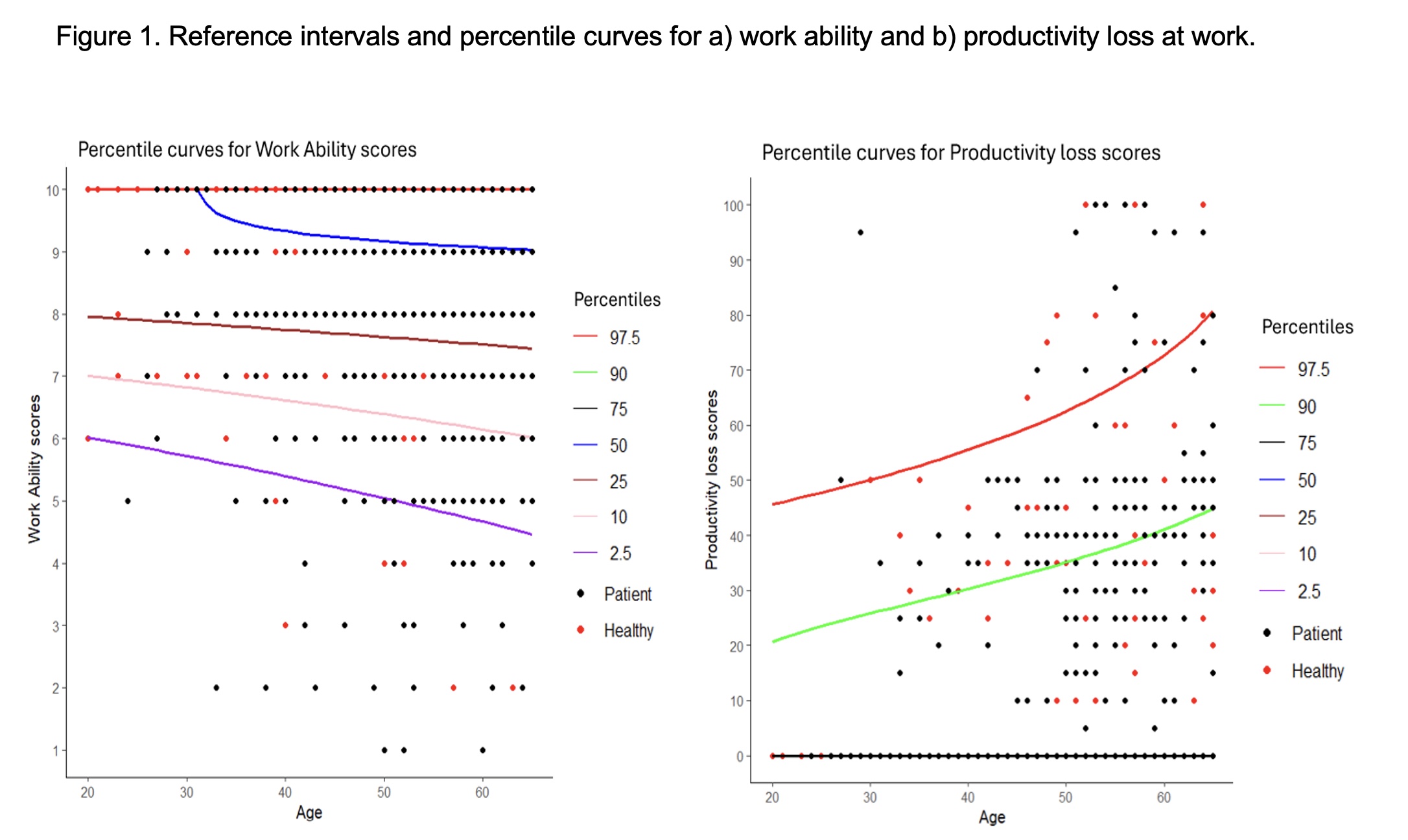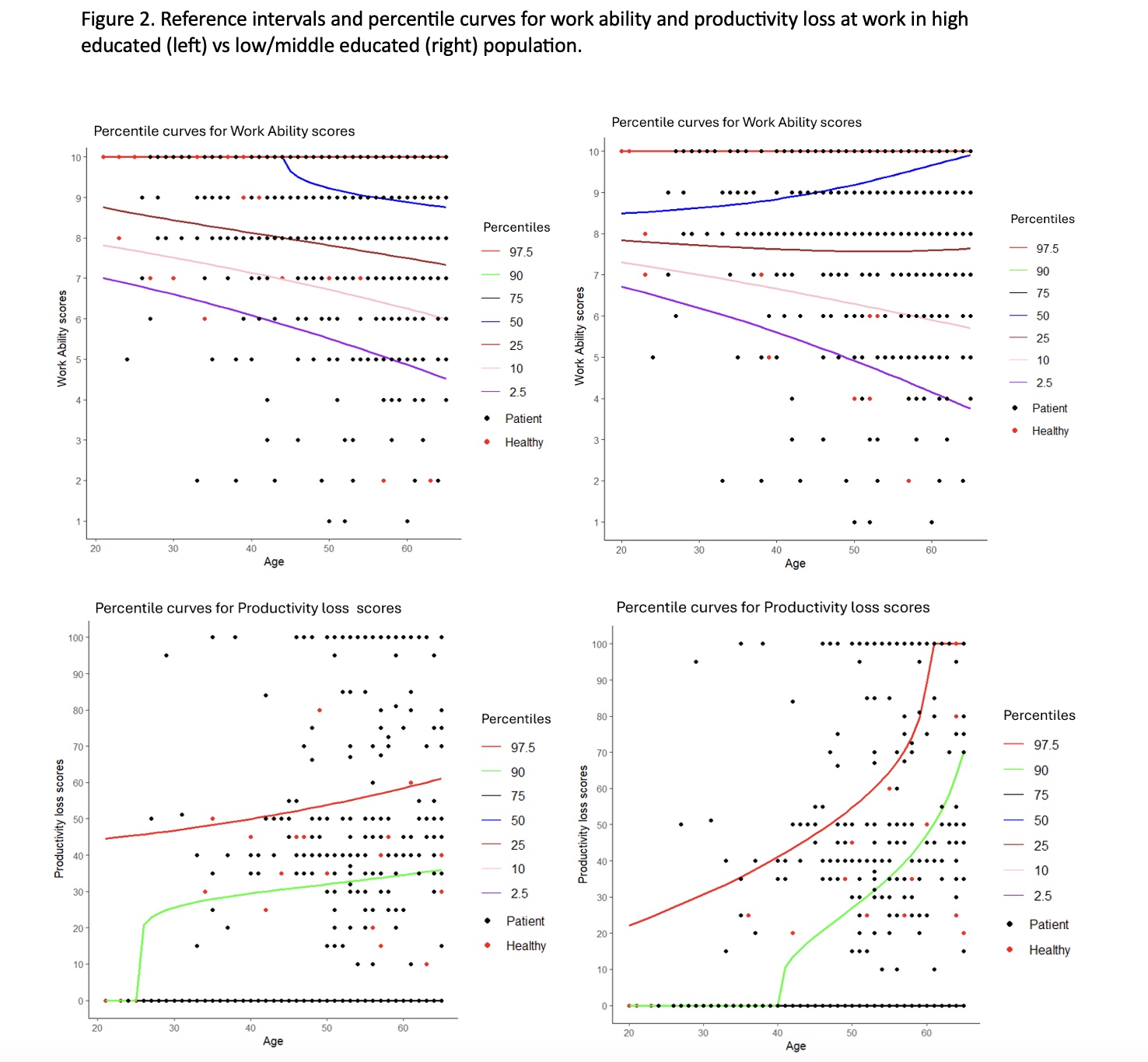Poster Session A
Epidemiology, health policy and outcomes
Session: (0117–0144) Epidemiology & Public Health Poster I
0123: Improving Interpretation of Work Outcomes in Patients with Inflammatory Rheumatic Musculoskeletal Disease: General Population Reference Curves for Work Ability and At-work Productivity
Sunday, November 12, 2023
9:00 AM - 11:00 AM PT
Location: Poster Hall
- SR
Sofia Ramiro, MD, PhD
Leiden University Medical Center
Bunde, NetherlandsDisclosure information not submitted.
Abstract Poster Presenter(s)
Dafne Capelusnik1, Wouter Smeets2, Casper Webers3, Sofia Ramiro4, Elena Nikiphorou5, Roel Braekers2, Laura Boekel6, Gertjan Wolbink7 and Annelies Boonen8, 1Tel Aviv Sourasky Medical Center, Tel Aviv, Israel, 2Data science institute, Hasselt University, Hasselt, Belgium, 3Maastricht University, Maastricht, Netherlands, 4Department of Rheumatology, Leiden University Medical Center, Leiden, Netherlands, 5King's College London, London, United Kingdom, 6Amsterdam Rheumatology and Immunology Center, Location Reade, Department of Rheumatology, Amsterdam, Netherlands, 7Reade, Amsterdam, Netherlands, 8Care and Public Health Research Institute (Caphri), Maastricht University, Maastricht, Netherlands
Background/Purpose: Data on self-reported presenteeism (limitations or reduced work productivity at work) in persons with inflammatory rheumatic and musculoskeletal diseases (iRMD) are challenging to interpret without a population benchmark, as presenteeism likely also occurs in the general working population. Our objective was to establish percentile curves (reference intervals [RI]) for ability and productivity while at paid work in a general working population.
Methods: A cross-sectional study was nested within an ongoing prospective Dutch cohort study on COVID-19, including patients with iRMD and general population controls. Participants with paid work (≥12 working hours/week) reported on work ability (Work Ability Index, range 0-10 [worst-best ability]) and work productivity (Work Productivity and Activity Impairment scale item 5 on productivity loss, range 0-100% [no-complete productivity loss]). A generalized additive model for location, shape and scale parameters (GAMLSS) with a zero-one inflated beta distribution was chosen to assess the association of age, gender, educational level, full- or part time employment and job demands with each presenteeism instrument (work ability, work productivity). Next, GAMLSS was used to establish age-specific RIs percentile curves for controls, stratified by relevant determinants when needed. Finally, the proportion of controls compared to patients with optimal outcomes (work ability=10 and productivity loss=0%) was calculated.
Results: A total of 446 controls were included; 327 (73%) were female, mean age 53 (SD 11) years, 188 (42%) had university education, mean work ability was 8.7 (1.6) [median 9 (IQR 2-10)] and mean at-work productivity loss 11% (25%) [0 (0-100)]. Education influenced work ability as well as work productivity loss. Percentile curves revealed that work ability decreases and productivity loss at work increases with age (Fig 1). While more than 50% of controls reported at least some impairment in work ability, more than 75% indicated having no productivity loss at work. Non-university education was strongly associated with both presenteeism outcomes. Stratification of percentile curves for work ability by education showed high variability in work ability with worse as well as better scores in small proportions of the older (compared to younger) controls (Fig 2). For productivity loss, non-university educated controls experienced increase in productivity loss in the older age groups. Plotting data form 494 patients with iRMD into the percentile curves revealed patients were less likely to have optimal work ability [151/494 (31%) vs 169/390 (43%) in controls] or no productivity loss [305/494 (62%) in patients vs 328/390 (83%) in controls]. Across percentiles, differences between patients and controls were larger for work productivity than work ability independent of age.
Conclusion: In the general working population work ability and productivity while at work are not perfect, indicating we should be cautious to not overestimate impact of iRMD on presenteeism. Notwithstanding, iRMD had evident impact on presenteeism compared to population controls, and this effect is stronger on productivity (output) than on ability (difficulty).


D. Capelusnik: None; W. Smeets: None; C. Webers: None; S. Ramiro: AbbVie, 2, 5, Eli Lilly, 2, Galapagos, 5, MSD, 2, 5, Novartis, 2, 5, Pfizer, 2, 5, Sanofi, 2, UCB Pharma, 2, 5; E. Nikiphorou: AbbVie/Abbott, 6, Celltrion, 6, Eli Lilly, 6, fresenius, 6, Galapagos, 6, Gilead, 1, 6, Pfizer, 6, Sanofi, 6; R. Braekers: None; L. Boekel: None; G. Wolbink: None; A. Boonen: AbbVie, 2, 5, 6, Galapagos, 2, 6, Novartis, 2, 6, Pfizer, 5, 6, UCB Pharma, 2, 6.
Background/Purpose: Data on self-reported presenteeism (limitations or reduced work productivity at work) in persons with inflammatory rheumatic and musculoskeletal diseases (iRMD) are challenging to interpret without a population benchmark, as presenteeism likely also occurs in the general working population. Our objective was to establish percentile curves (reference intervals [RI]) for ability and productivity while at paid work in a general working population.
Methods: A cross-sectional study was nested within an ongoing prospective Dutch cohort study on COVID-19, including patients with iRMD and general population controls. Participants with paid work (≥12 working hours/week) reported on work ability (Work Ability Index, range 0-10 [worst-best ability]) and work productivity (Work Productivity and Activity Impairment scale item 5 on productivity loss, range 0-100% [no-complete productivity loss]). A generalized additive model for location, shape and scale parameters (GAMLSS) with a zero-one inflated beta distribution was chosen to assess the association of age, gender, educational level, full- or part time employment and job demands with each presenteeism instrument (work ability, work productivity). Next, GAMLSS was used to establish age-specific RIs percentile curves for controls, stratified by relevant determinants when needed. Finally, the proportion of controls compared to patients with optimal outcomes (work ability=10 and productivity loss=0%) was calculated.
Results: A total of 446 controls were included; 327 (73%) were female, mean age 53 (SD 11) years, 188 (42%) had university education, mean work ability was 8.7 (1.6) [median 9 (IQR 2-10)] and mean at-work productivity loss 11% (25%) [0 (0-100)]. Education influenced work ability as well as work productivity loss. Percentile curves revealed that work ability decreases and productivity loss at work increases with age (Fig 1). While more than 50% of controls reported at least some impairment in work ability, more than 75% indicated having no productivity loss at work. Non-university education was strongly associated with both presenteeism outcomes. Stratification of percentile curves for work ability by education showed high variability in work ability with worse as well as better scores in small proportions of the older (compared to younger) controls (Fig 2). For productivity loss, non-university educated controls experienced increase in productivity loss in the older age groups. Plotting data form 494 patients with iRMD into the percentile curves revealed patients were less likely to have optimal work ability [151/494 (31%) vs 169/390 (43%) in controls] or no productivity loss [305/494 (62%) in patients vs 328/390 (83%) in controls]. Across percentiles, differences between patients and controls were larger for work productivity than work ability independent of age.
Conclusion: In the general working population work ability and productivity while at work are not perfect, indicating we should be cautious to not overestimate impact of iRMD on presenteeism. Notwithstanding, iRMD had evident impact on presenteeism compared to population controls, and this effect is stronger on productivity (output) than on ability (difficulty).

Figure 1. Reference intervals and percentile curves for a) work ability and b) productivity loss at work.

Figure 2. Reference intervals and percentile curves for work ability and productivity loss at work in high educated (left) vs low/middle educated (right) population.
D. Capelusnik: None; W. Smeets: None; C. Webers: None; S. Ramiro: AbbVie, 2, 5, Eli Lilly, 2, Galapagos, 5, MSD, 2, 5, Novartis, 2, 5, Pfizer, 2, 5, Sanofi, 2, UCB Pharma, 2, 5; E. Nikiphorou: AbbVie/Abbott, 6, Celltrion, 6, Eli Lilly, 6, fresenius, 6, Galapagos, 6, Gilead, 1, 6, Pfizer, 6, Sanofi, 6; R. Braekers: None; L. Boekel: None; G. Wolbink: None; A. Boonen: AbbVie, 2, 5, 6, Galapagos, 2, 6, Novartis, 2, 6, Pfizer, 5, 6, UCB Pharma, 2, 6.



